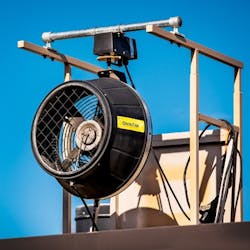Odor Control: A Good Neighbor
It used to be that wastewater treatment facilities were located far from homes, restaurants, businesses and parks. However, urban sprawl in many cities has changed this landscape, and many treatment plants now exist in heavily populated areas.
This demographic shift creates significant odor challenges for wastewater treatment plants. Most have multiple odor-generating areas, which include pump stations, headworks, primary clarifiers, digesters, lagoons and sludge handling areas. In addition, hydrogen sulfide, ammonia, sulfur dioxide, skatoles, mercaptans, amines and indoles can generate foul odors.
In order to fully mitigate all odor complaints from neighbors, today’s wastewater treatment plants need to develop the right odor management strategies to avoid ending up on the front page of the local newspaper.
The Rise of Eco-Friendly Solutions
Eliminating foul odors is not enough. Modern eco-friendly industrial odor control solutions should be non-toxic—for the safety of industrial employees, the public and the environment. In fact, they should be readily biodegradable—at least 60% to 100% in 28 days—to be safer for the environment.
For example, Ecosorb, an eco-friendly odor abatement solution often used for landfills, oil refineries and municipal wastewater facilities, is an effective solution. It avoids the use of odor-masking agents, which can be toxic, and has been scientifically proven to be safe for the environment.
It contains no hazardous volatile organic compounds, and is safe for both humans and the environment. The product also has been tested against U.S. Environmental Protection Agency Guidelines, and received the safest possible classification.
Wheaton Sanitation District
Not far from Chicago is the Wheaton Sanitation District in Wheaton, Ill. The city features many new residential homes, as well as newly built baseball fields, schools and community parks in close proximity to the wastewater treatment plant.
The Wheaton Sanitation District was looking to take a progressive approach to using eco-friendly odor management solutions that were safe for its employees, neighbors and the environment. This was especially important given the number of parks, fields and tree-lined areas families frequent near the plant.
“In order to minimize odor complaints, we decided to take a proactive odor management approach,” said Sue Baert, plant superintendent for the Wheaton Sanitation District. “We wanted a system that used eco-friendly solutions that were both highly effective and safe for employees, as well as the community and the environment at large.”
As with many wastewater treatment plants, the Wheaton Sanitation District found that its sludge handling areas often produced the strongest odor. Through its partnership with OMI Industries, the facility solved its odor challenge by developing an atomization solution using Ecosorb.
The solution included OMI Industries’ 450CFM Vapor Phase unit, which treats odors emanating from the sludge storage building. The plant manager chose this solution because the facility did not have water for product dilution. This unit generates sub-micron-sized droplets of Ecosorb 606, which are dispersed into the building using a PVC header system placed in the rafters, running down the middle of the building. The system is only used when sludge cake is being added to or removed from the building.
Stopping Odors
For the raw sewage coming into the preliminary treatment building for processing, the Wheaton Sanitation District installed the 2-gal-per-minute high-pressure system to distribute Ecosorb atomization through a high-pressure hydraulic system, which disperses a fine mist into the air to simultaneously treat escaping gas emissions and surface odors.
Screw pumps are used to lift the raw sewage into the preliminary treatment building, but odors still escape, even though it is covered. To mitigate this issue, the facility has surrounded this area with high-pressure atomization nozzles.
Summer Odors
Especially in summer, nobody wants foul odors making their way into backyards and playgrounds when neighbors want to enjoy the weather outside.
“Many of our neighbors like to host family barbecues in the summer months, and the last thing they want is to experience wastewater odors wafting into their yards,” Baert said. “With luxury homes abutting right up to our property, we decided to develop another customized solution to make us a good neighbor, which was an odor fan.”
The customized fan dispersal system was installed on top of the chemical building. It senses when odors are present and/or the wind direction impacts neighbors. The odor fan emits a steady flow of Ecosorb directed at its neighbors’ properties, and can be adjusted at any time.
A Proactive Approach
The goal of being both a good neighbor and providing the most effective wastewater treatment services is no small challenge for any facility.
However, by developing a proactive odor management approach, the Wheaton Sanitation District was able to significantly cut down on complaints, while also ensuring that the environment is not negatively impacted, showing that it is possible to be a good neighbor by mitigating odors in a way that is safe for everyone.
Download: Here
